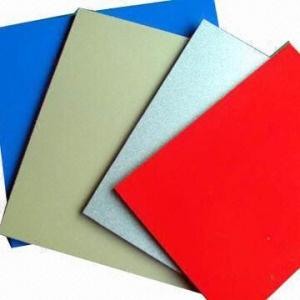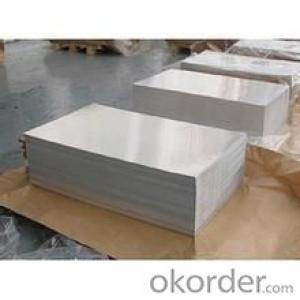Thin Moldable Aluminum Sheets for Finished Insignia Boards
- Loading Port:
- Shanghai
- Payment Terms:
- TT OR LC
- Min Order Qty:
- 2 m.t.
- Supply Capability:
- 50000 m.t./month
OKorder Service Pledge
OKorder Financial Service
You Might Also Like
Specification
Description
| Finished Aluminium Panel Used For Insignia Board | |||||
Alloy No. | Thickness (mm) | Width (mm) | Length (mm) | Temper | |
A1050,A1060, A1070, A1100 | 0.2-100 | 20-2200 | 20-8000 | O,H12,H22,H14,H16,H18, H24,H26,etc | |
3A21, A3003, A3105, A3004 | 0.2-100 | 20-2200 | 20-8000 | O,H14,H18,H24,etc | |
A5052, A5005, A5083, A5754 | 0.2-100 | 20-2200 | 20-8000 | O,H18,H24,H32,H34,H111,H112 ,etc | |
A6061, A6082, A6063 | 0.2-200 | 20-2200 | 20-8000 | T4,T6, T651,etc | |
A8011 | 0.2-100 | 20-2200 | 20-8000 | O,H12,H22,H14,H16,H18,H24,H26, etc | |
Packing: Export wooden pallets. The bundle weight not exceed 2MT. Loading: by 1x20GP, 1X20GP can load about 25MT. | |||||
Standards: ASTM-B209. EN573-1, GB/T3880.1-2006 | |||||
Quality of material: totally free from defects like white rust, oil patches, roll marks, edge damage, camber, dents, holes, break lines, scratches and free from coil set. | |||||
Application : Mainly used insigns, billboards, building exterior decoration, bus body, high-rise buildings and factories wall decoration, kitchen sink, lamp, fan leaves, with pieces of electronic, chemical equipment, sheet metal processing parts, deep drawing or spinning hollowware, welding parts, heat exchangers, bell surface and disk, plate, kitchenware, decorations, reflective devices, ect | |||||
MOQ | 5 tons | ||||
Payment term | T/T,L/C | ||||
Delivery Time | 15-60 days after 30% T/T payment or receiving L/C copy | ||||
Kind attention: Specifications can be customized as the customer’s requirements. | |||||
PVDF and PE coated aluminium coils/sheets:
PVDF color pre coated aluminum coils/ sheets:
It is well known that fluorocarbon lacquer coating (PVDF coating) owes the best acid resistant/alkali and temperature tolerant capabilities of all painting materials. Being the best quality of precoated aluminum, PVDF coated coils are especially suitable for outdoor roofing walls and ceiling manufacturing.
Polyester (PE) color pre coated aluminum coils/ sheets :
Using high-grade polyester lacquer coating material, the finished coated coils are with delicate color uniform texture, color and diverse. It is the most popular and most common used materials in decorative usage. The PE coated aluminum are widely used in ACP( aluminum composite panel ) production and indoor ceiling usage.


Production facilities and processing range
Equipments | Quantity | Thickness range | Width range | Length range | Max loading weight |
Continuous casting rolling mill | 23 | 6.0-10.0mm | 1000-2000mm | ------------- | 15000kgs |
Cold rolling mill | 2 | 0.1-6.0mm | 900-1700mm | ------------- | 12000kgs |
High accuracy cold rolling line | 1 | 0.1-1.0mm | 650-1420mm | ------------- | OD 2000mm |
Annealer | 14x40T | ------------- | -------------- | ------------- | ------------- |
Coating line | 3 | 0.15-1.5mm | 600-1600mm | ------------- | 5000kgs |
Embossing line | 1 | 0.2-1.2mm | 350-1300mm | ------------- | 8500kgs |
Straightening line | 1 | 0.1-2.0mm | 600-1700mm | ------------- | 10000kgs |
Slitting line | 1 | 0.2-3.0mm | 21-1595mm | ------------- | 10000kgs |
Wave shearing line | 1 | 0.13-0.5mm | 550-1230mm | ------------- | 10000kgs |
Shearing line | 3 | 0.125-4.0mm | Max 1700mm | ------------- | 10000kgs |
FAQ
Q: Can you provide free samples?
A: Yes, free samples will be sent to you on freight at destination.
Q: Can I get your latest catalogue?
A: Yes, it will be sent to you in no time.
Q: What are your payment terms?
A: We accept L/C, D/A, D/P, T/T, West Union, etc
Q: Can you provide free samples?
A: Yes, free samples will be sent to you on freight at destination.
Q: Can I get your latest catalogue?
A: Yes, it will be sent to you in no time.
Q: What is the MOQ?
A: 5 tons.
Q: What are your payment terms?
A: We accept L/C, D/A, D/P, T/T, West Union, etc
- Q: (1) Aluminum is malleable. (2) Aluminum reacts with sulfuric acid.(3) Aluminum conducts an electric current.(4)Aluminum has a density of 2.698 g/cm3 at STP.Explain why.
- oxygen supports combustion is the chemical one
- Q: Can aluminum sheets be used for modular construction?
- Yes, aluminum sheets can be used for modular construction. Aluminum is a versatile and lightweight material that offers several benefits for modular construction projects. It is durable, corrosion-resistant, and has a high strength-to-weight ratio, making it suitable for various structural applications. Aluminum sheets can be easily fabricated and formed into different shapes and sizes, allowing for flexibility in design and construction. Additionally, aluminum is recyclable, making it an environmentally friendly choice for sustainable construction practices. Overall, aluminum sheets are a viable option for modular construction due to their strength, durability, and versatility.
- Q: why is it gd and what are common aluminium compounds??? thx
- It's quite expensive to make aluminum, whereas it's quite cheap to melt it down and reuse it.
- Q: Are aluminum sheets suitable for signage?
- Yes, aluminum sheets are suitable for signage. They are lightweight, durable, and weather-resistant, making them a popular choice for outdoor and indoor signage applications. Additionally, aluminum sheets can be easily customized, printed, and mounted, allowing for versatile and long-lasting signage solutions.
- Q: Can aluminum sheets be used for heat dissipation?
- Yes, aluminum sheets can be used for heat dissipation due to their high thermal conductivity.
- Q: Can aluminum sheets be used for boat building?
- Yes, aluminum sheets can be used for boat building. Aluminum is a popular material choice due to its strength, durability, and resistance to corrosion. It is lightweight and easy to work with, making it suitable for constructing various types of boats. Additionally, aluminum boats are known for their longevity and low maintenance requirements.
- Q: Are the aluminum sheets suitable for manufacturing electrical busbars?
- Indeed, electrical busbars can be manufactured using aluminum sheets. The remarkable electrical conductivity and lightweight nature of aluminum render it a preferred option for busbars. It effectively carries substantial electrical currents and boasts low resistance, making it exceptionally suitable for transporting electricity in power distribution networks. Moreover, aluminum sheets can be effortlessly manipulated and molded into diverse forms and dimensions, granting the opportunity for personalized designs and streamlined integration into electrical systems.
- Q: Are aluminum sheets resistant to impact and vibration?
- Yes, aluminum sheets are generally resistant to impact and vibration. Aluminum is known for its high strength-to-weight ratio, making it a durable and lightweight material. It has good mechanical properties, including excellent resistance to impact and vibration. Aluminum sheets are often used in applications that require protection against impact and vibrations, such as automotive parts, aircraft structures, and building facades. Additionally, aluminum can be alloyed with other elements to enhance its impact resistance and reduce vibrations. Overall, aluminum sheets are a reliable choice for withstanding impact and vibration forces.
- Q: Can aluminum sheets handle high temperatures?
- Yes, aluminum sheets can handle high temperatures. Aluminum has a high melting point of 660 degrees Celsius (1220 degrees Fahrenheit), making it suitable for many high-temperature applications. Additionally, aluminum has excellent thermal conductivity, which allows it to quickly dissipate heat. This property makes aluminum sheets suitable for use in areas that require high-temperature resistance, such as engine components, heat exchangers, and oven linings. However, it is important to consider the specific alloy and thickness of the aluminum sheet, as different alloys may have varying temperature limits.
- Q: Can the aluminum sheets be used for roofing or siding purposes?
- Certainly! Both roofing and siding purposes can benefit from the use of aluminum sheets. The lightweight nature, durability, and corrosion resistance of aluminum make it a favored option for these applications. Its ability to endure severe weather conditions, such as rain, snow, and UV rays, has made it popular in residential, commercial, and industrial constructions. Moreover, aluminum's versatility enables easy shaping, which opens up numerous design possibilities.
Send your message to us
Thin Moldable Aluminum Sheets for Finished Insignia Boards
- Loading Port:
- Shanghai
- Payment Terms:
- TT OR LC
- Min Order Qty:
- 2 m.t.
- Supply Capability:
- 50000 m.t./month
OKorder Service Pledge
OKorder Financial Service
Similar products
Hot products
Hot Searches
Related keywords


























